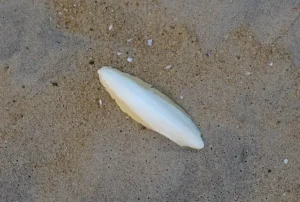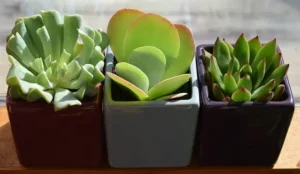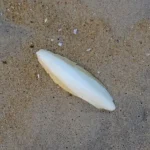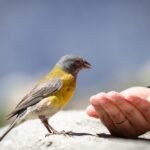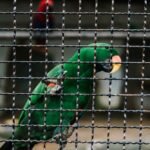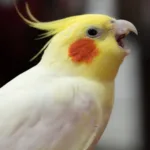Parrots are known for their grooming behaviors. They preen their feathers regularly, making sure they are clean at all times. But despite their fastidious nature, they can get lice.
Lice are a type of external parasite that infest parrot’s feathers and feed on their blood. A louse infestation can cause itching, discomfort, and, feather damage.
If it is not treated in time, this infestation can lead to severe blood loss and even death in parrots. Therefore, it’s important to learn how to identify lice on parrots and provide them with appropriate treatment.
Quick Navigation
What Are Bird Lice?
Lice are classified as ectoparasites, which means they rely on the host’s body for survival and reproduction. These creatures live between the feathers of birds and lay eggs on their skin.
There are two main types of ectoparasites. These include biting/chewing lice and sucking lice. Biting lice are more commonly seen in birds. These types of louse can survive by eating feathers and bodily secretions.
Usually biting lice do not do much harm to their hosts, but they can cause severe itching. Sucking lice on the other hand feed on the bird’s blood and can lead to significant blood loss if the infestation is left unchecked.
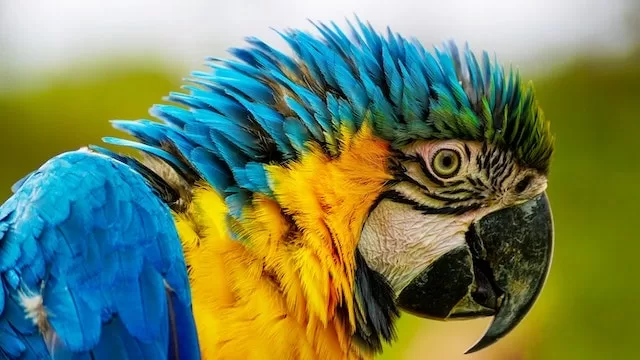
How Do Parrots Get Lice?
Lice infestation is most common in parrots living in unsanitary conditions. It can reach them either directly or indirectly through contaminated items like their food and water bowls. Baby parrots are generally more susceptible to getting lice from poor hygiene.
Lice in parrots can also be caused by exposure to lice-infested birds if they come into close contact. Parrots that share a large cage with other birds or live in aviaries are more likely to get lice. It can also be transmitted from an infected bird introduced in the cage. Lice typically jump from one bird to another through direct contact, which can happen if they share the same cage.
Common causes of lice infestation in birds:
- Unsanitary environments
- Introduction of new bird in the household
- Aviaries with lots of birds
How Can You Tell If Your Parrot Has Lice?
There are various types of external parasites that can affect parrots. Some of them may be visible to the naked eye while others can be microscopic. So if you see something moving on your parrot’s feathers, it does not necessarily mean that lice have inhabited your bird.
Parrots can also be infested by fleas and bird mites. Mites are microscopic creatures and cannot be seen crawling. On the other hand, fleas are also a type of ectoparasites but they do not burrow inside the feather shafts like lice and move more frequently.
Lice are less mobile parasites. They are also larger in size so they can be spotted sitting between the feathers. Parrot lice can grow up to 5mm in length, and be seen attached to the feather shafts of the bird.
If you think your parrot might have lice, you can carefully inspect its feathers. Lice are usually reddish-brown in color and can be found clinging to the parrot’s skin or feathers.
Lice can be more active during the night and make it hard for the parrot to sleep. If your parrot itches through the night and is not able to get adequate sleep, it could be due to a lice infestation.
Symptoms of feather lice in birds:
- Over preening
- Visible between the feathers
- Itching
- Fluffed feathers
- Feather damage and discoloration
- Labored breathing
How To Treat Parrot Lice?
When trying to manage lice infestation in birds, always make sure to use vet-prescribed medication and follow their advice to administer it properly.
Lice infestations in parrots can be treated with medications and topical sprays recommended by a veterinarian. If caught early, the vet may suggest treatment for parrot lice that involves insecticides such as pyrethrin sprays.
In some cases, the parrot may be prescribed oral medications along with the insecticides such as ivermectin or moxidectin, which can be given to them in their water.
However, treating the louse alone does not guarantee that the parrot will not be infested by lice again. Since the root of the problem in most cases is environmental, it is essential that you disinfect the parrot’s cage, living area, and all the other accessories such as toys and food bowls. Lice cannot survive long without a host. A thorough disinfection of the parrot’s surroundings will be able to effectively kill the lice.
Can Humans Get Lice From Birds?
Feather lice do not affect humans and in most cases, will stick to its avian host. Bird lice can sometimes get on human skin, but they won’t suck blood from the sick or infest your hair. They can, however, bite which can cause itchiness. But don’t worry, feather lice cannot live on humans for long. So even if you get lice from birds, they can just be washed out.
How To Prevent Lice Infestation In Parrots?
Lice is quite common in parrots and other pet birds so there can always be the risk of getting bird lice around the house. But if you take the right measures and keep your parrot clean, you will not have to worry about a lice infestation again. These are the following methods to prevent lice on parrots:
Keep Their Environment Clean
There are several steps to prevent lice on parrots, but first, you need to make sure that it does not breed in their living environment. By far the most common cause of infections and lice infestation in parrots is an unhygienic environment. An unclean cage, bad food, and stale water are all breeding grounds for various kinds of infectious diseases.
To maintain proper hygiene, regular disinfection of the cage and its accessories is a must. You can do this using an apple cider vinegar solution. On top of regular upkeep of the cage, remember to provide clean water and a healthy diet for your parrot.
Quarantine New Birds
As important as it is to treat lice infestations in parrots, taking preventive measures is equally crucial in order to avoid this problem altogether. Lice can easily move from one bird to another when they’re close.
As lice continue to multiply on their host, they will infest another bird they find to lay eggs and grow their population. It is not long before these eggs hatch producing more young lice. That is why it is crucial to quarantine new birds as they may be potential carriers of such external parasites.
Herbal Sprays
As a preventative measure, you can add certain types of anti-bacterial herbs to your parrot’s bathing water or spray it directly on them. Neem tree leaves and lemon grass are two of the best herbs you can use to keep lice away from your parrot’s feathers. Lemon grass is a natural deterrent to all kinds of parasites and can also be effective in treating lice on parrots.

